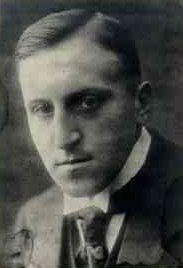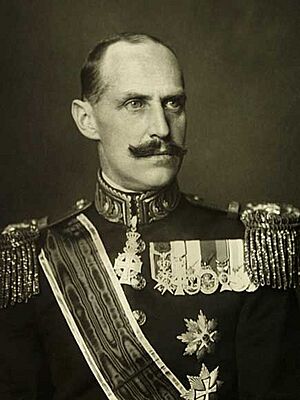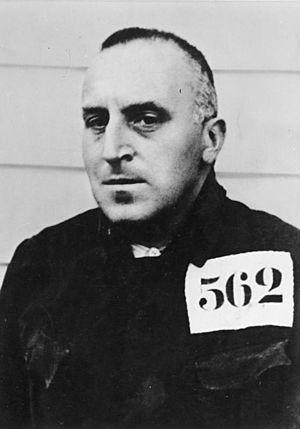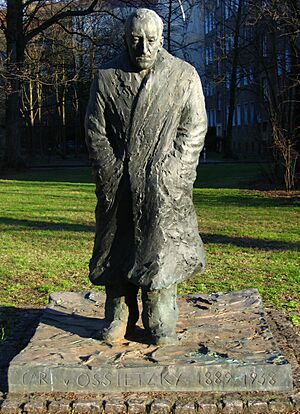Carl von Ossietzky facts for kids
Quick facts for kids
Carl von Ossietzky
|
|
|---|---|

Photograph of Ossietzky taken in 1915
|
|
| Born | 3 October 1889 |
| Died | 4 May 1938 (aged 48) |
| Occupation | German journalist, political activist |
| Spouse(s) | Maud Lichfield-Woods (British) |
| Children | Rosalinde von Ossietzky-Palm |
| Awards | Nobel Peace Prize (1935) |
Carl von Ossietzky (3 October 1889 – 4 May 1938) was a German journalist and a pacifist. A pacifist is someone who believes that war and violence are wrong and should be avoided. He won the 1935 Nobel Peace Prize for bravely showing the world that Germany was secretly rebuilding its army.
As the main editor of a magazine called Die Weltbühne, Ossietzky wrote many articles in the late 1920s. These articles revealed that Germany was breaking the Treaty of Versailles. This treaty, signed after World War I, limited Germany's military power. Ossietzky showed that Germany was secretly building an air force and training pilots in the Soviet Union.
Because he revealed these secrets, he was arrested in 1931. He was accused of sharing government secrets and was sent to prison for eighteen months. However, he was released early in December 1932.
Ossietzky kept speaking out against Germany's military plans even after Adolf Hitler and the Nazi Party came to power. After a big fire in the German parliament building in 1933, Ossietzky was arrested again. He was sent to a very harsh prison camp called Esterwegen concentration camp. In 1936, he was given the 1935 Nobel Peace Prize. But the Nazi government stopped him from traveling to Norway to accept it. After suffering a lot of abuse and mistreatment in different Nazi prison camps, Ossietzky died in 1938 from a serious illness called tuberculosis.
Contents
Carl Ossietzky's Early Life
Carl von Ossietzky was born in Hamburg, Germany, on October 3, 1889. His father, Carl Ignatius von Ossietzky, was from a region called Upper Silesia. His mother, Rosalie, was a strong Catholic who hoped Carl would become a priest. Carl's father passed away when Carl was only two years old.
The "von" in Ossietzky's name usually means someone comes from a noble family. Carl himself joked that it came from an ancestor who served in a Polish cavalry unit. He said the king couldn't pay his soldiers, so he made them all nobles instead!
Even though Carl didn't finish high school, he became a successful journalist. He wrote about many different topics, from theater plays to women's rights and the early days of cars. He later said that seeing Germany's military power grow before World War I made him a pacifist by 1913.
In that same year, he married Maud Lichfield-Woods, a British woman from Manchester. She was a suffragette, meaning she fought for women's right to vote. They had one daughter named Rosalinda. During World War I, Carl was forced to join the army. His experiences in the war made his belief in pacifism even stronger. After the war, during a time known as the Weimar Republic (1919–1933), his writings showed him to be a strong supporter of democracy and a society where many different ideas could exist.
Discovering Germany's Secret Military Plans
In 1921, the German government created "work squads" called Arbeits-Kommandos. These groups were led by Major Bruno Ernst Buchrucker. They were officially meant to help with civilian projects. But in reality, Germany used them to secretly have more soldiers than the Treaty of Versailles allowed.
These secret squads, sometimes called the "Black Reichswehr," took orders from a hidden group within the German Army. This group included important officers like Kurt von Schleicher. The Black Reichswehr became known for secretly killing Germans they thought were giving information to the Allied Control Commission. These killings were done through a secret system called Femegerichte, where people were found "guilty" without knowing they were on trial.
Because of his strong belief in peace, Ossietzky became the secretary of the German Peace Society in 1919.
The "Homeless Left" Movement
In the 1920s, Carl von Ossietzky became a leader of a group called the "homeless left." This group was centered around the newspaper Die Weltbühne. They did not support Communism, but they also felt that the main Social Democratic Party was too willing to compromise with the old ways of Germany.
Ossietzky often pointed out that many of the same people who worked in government, as judges, and in the military under the old German Emperor were now serving the new Weimar Republic. He worried that these people did not truly believe in democracy and would turn against the republic if they had the chance.
At Die Weltbühne, Ossietzky helped publish a study in 1923. It showed that German judges gave very harsh sentences to people who broke laws for left-wing causes. But they gave very light sentences to those who committed violence for right-wing causes. He often compared cases, like a Social Democrat who was imprisoned for revealing secrets, to a military captain whose men killed many civilians but was never tried. Ossietzky also criticized those who claimed to believe in democracy but didn't truly understand what it meant.
In 1927, Ossietzky took over as the main editor of Die Weltbühne magazine. In 1932, he supported Ernst Thälmann for president, even though he still disagreed with some policies of the Communist Party of Germany.
The Abteilung M Secret
In 1929, a writer for Die Weltbühne, Walter Kreiser, revealed a big secret. He wrote about a special air unit of the German army called Abteilung M (Section M). This unit was secretly training pilots in Germany and in Soviet Russia. This was a clear violation of the Treaty of Versailles, which limited Germany's military.
Later that year, Kreiser and Ossietzky, as the editor, were questioned by a high court judge. In 1931, they were officially accused of "treason and espionage." The government claimed they had shared state secrets that were meant to be hidden. Many people at the time saw these arrests as an attempt to silence Die Weltbühne, which often criticized the army's secret expansion.
The lawyers for Kreiser and Ossietzky argued that the information they published was true. They also pointed out that the budget for Abteilung M had actually been mentioned in reports by the German parliament's budgeting committee. However, the prosecution argued that Kreiser and Ossietzky should have known it was a state secret. They said this was clear when the Ministry of Defense refused to comment on Abteilung M.
Kreiser and Ossietzky were found guilty and sentenced to eighteen months in prison. Kreiser left Germany, but Ossietzky stayed and went to prison. He was released at the end of 1932 as part of a Christmas release.
Arrest by the Nazis
Carl von Ossietzky continued to warn people about militarism and the rise of the Nazis. When Adolf Hitler became the leader of Germany in January 1933, the Nazi dictatorship began. Even then, Ossietzky was one of the few public figures who kept speaking out against the Nazi Party.
On February 28, 1933, after the Reichstag fire, he was arrested. He was held in a special kind of custody in Spandau prison. One of Ossietzky's biographers believes that if he had had a few more days, he would have left the country like many other writers. It seems Ossietzky didn't realize how quickly the Nazis would get rid of their political opponents.
He was later held in the Esterwegen concentration camp near Oldenburg, among other camps. During his time in these camps, Ossietzky was treated very badly by the guards and was often starved. In November 1935, a representative from the International Red Cross visited Ossietzky. He reported seeing a "trembling, deadly pale something, a creature that appeared to be without feeling, one eye swollen, teeth knocked out, dragging a broken, badly healed leg . . . a human being who had reached the uttermost limits of what could be borne."
The 1935 Nobel Peace Prize
Carl von Ossietzky became famous around the world in 1936. This was when he was awarded the 1935 Nobel Peace Prize, even though he was already very sick with tuberculosis. The German government could not stop him from getting the award. However, they refused to let him travel to Oslo, Norway, to accept the prize himself.

The award caused a lot of debate. Two members of the Nobel Prize committee even resigned because of it. King Haakon VII of Norway, who usually attended these ceremonies, stayed away from this one.
The award divided public opinion and was generally criticized by conservative groups. A leading conservative Norwegian newspaper argued that Ossietzky was a criminal who had attacked his country. They said he used methods that broke the law long before Hitler came to power.
Ossietzky's Nobel Prize was not allowed to be mentioned in German newspapers. The government also made a rule that German citizens could not accept any future Nobel Prizes.
Death
In May 1936, Ossietzky was moved to a hospital in Berlin-Charlottenburg because of his tuberculosis. He was still under constant watch by the Gestapo, the Nazi secret police. On May 4, 1938, he died in a Berlin hospital. He was still in police custody. His death was caused by tuberculosis and the terrible abuse he suffered in the prison camps.
Carl Ossietzky's Legacy
Many people have compared Carl von Ossietzky to Liu Xiaobo, a Chinese activist who also won the Nobel Peace Prize. Both were stopped by their governments from accepting their awards, and both died while still being held by authorities. The International League for Human Rights (Berlin) gives out an annual Carl von Ossietzky Medal. This award honors people or groups who work to protect basic human rights.
In 1963, East German television made a film about Ossietzky's life. He is also shown as a character in the graphic novel series Berlin by Jason Lutes.
In 1991, the University of Oldenburg was renamed Carl von Ossietzky University of Oldenburg in his honor. His daughter, Rosalinde von Ossietzky-Palm, attended the ceremony.
In 1992, a German court reviewed Ossietzky's 1931 conviction. The court decided to uphold the original conviction, applying the laws as they were in 1931.
See also
 In Spanish: Carl von Ossietzky para niños
In Spanish: Carl von Ossietzky para niños
- List of peace activists





